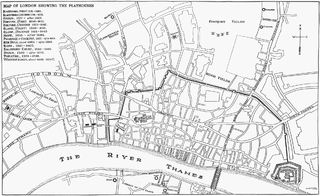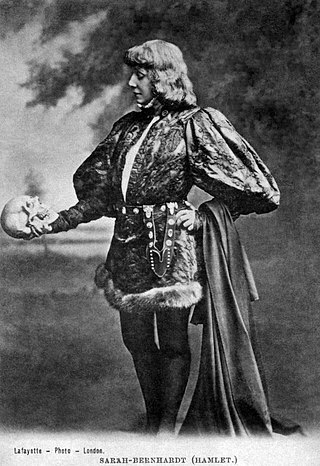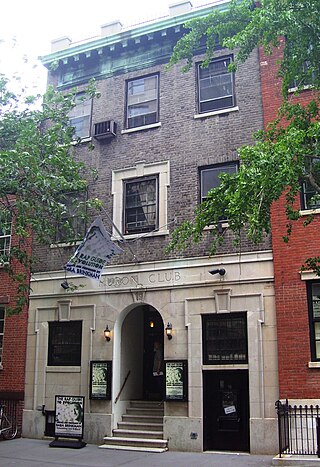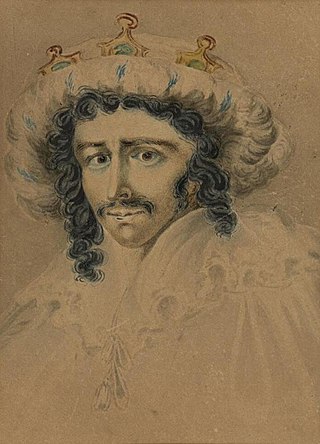Related Research Articles

The Red Bull was an inn-yard conversion erected in Clerkenwell, London, operating in the 17th century. For more than four decades, it entertained audiences drawn primarily from the City and its suburbs, developing a reputation over the years for rowdiness. After Parliament closed the theatres in 1642, it continued to host illegal performances intermittently, and when the theatres reopened after the Restoration, it became a legitimate venue again. There is a myth that it burned down in the Great Fire of London but the direct reason for its end is unclear.

The Theatre Royal, Drury Lane, commonly known as Drury Lane, is a West End theatre and Grade I listed building in Covent Garden, London, England. The building faces Catherine Street and backs onto Drury Lane. The present building, opened in 1812, is the most recent of four theatres that stood at the location since 1663, making it the oldest theatre site in London still in use. According to the author Peter Thomson, for its first two centuries, Drury Lane could "reasonably have claimed to be London's leading theatre". For most of that time, it was one of a handful of patent theatres, granted monopoly rights to the production of "legitimate" drama in London.

The African GroveTheatre opened in New York City in 1821. It was founded and operated by William Alexander Brown, a free black man from the West Indies. It opened six years before the final abolition of slavery in New York state. The African Grove Theatre was attended by "all types of black New Yorkers -- free and slave, middle-class and working-class" along with others. It was the first place where Ira Aldridge, who would later become an esteemed and renowned Shakespearian actor, first saw a production of a Shakespeare play.

The Theatre Royal is an Edwardian theatre on Thames Street in Windsor in Berkshire. The present building is the second theatre to stand on this site and opened on 13 December 1910. Built for Sir William Shipley and Captain Reginald Shipley, it was a replacement for their previous theatre which was built in 1815 and had burnt down in 1908. The present theatre was designed by Frank Verity, the son of the theatre architect Thomas Verity. The building is Grade II listed and is the only unsubsidised producing theatre to operate all year round in the United Kingdom.
The Bowery Amphitheatre was a building in the Bowery neighborhood of New York City. It was located at 37 and 39 Bowery, across the street from the Bowery Theatre. Under a number of different names and managers, the structure served as a circus, menagerie, theatre, a roller rink, and a branch of the Peniel Mission. The site is now part of Confucius Plaza.

The Chatham Garden Theatre or Chatham Theatre was a playhouse in the Chatham Gardens of New York City. It was located on the north side of Chatham Street on Park Row between Pearl and Duane streets in lower Manhattan. The grounds ran through to Augustus Street. The Chatham Garden Theatre was the first major competition to the high-class Park Theatre, though in its later years it sank to the bottom of New York's stratified theatrical order, below even the Bowery Theatre.

Niblo's Garden was a theater on Broadway and Crosby Street, near Prince Street, in SoHo, Manhattan, New York City. It was established in 1823 as "Columbia Garden" which in 1828 gained the name of the Sans Souci and was later the property of the coffeehouse proprietor and caterer William Niblo. The large theater that evolved in several stages, occupying more and more of the pleasure ground, was twice burned and rebuilt. On September 12, 1866, Niblo's saw the premiere of The Black Crook, considered to be the first piece of musical theater that conforms to the modern notion of a "book musical".

Nassau Street is in the Financial District, within the borough of Manhattan in New York City. Its southern end is at the intersection with Broad Street and Wall Street, and its northern end is at Spruce Street, at Pace University near the foot of the Brooklyn Bridge. For its entire route, Nassau Street runs one block east of Broadway and Park Row.

Three New York City playhouses named Wallack's Theatre played an important part in the history of American theater as the successive homes of the stock company managed by actors James W. Wallack and his son, Lester Wallack. During its 35-year lifetime, from 1852 to 1887, that company developed and held a reputation as the best theater company in the country.

Booth's Theatre was a theatre in New York built by actor Edwin Booth. Located on the southeast corner of 23rd Street and Sixth Avenue, Booth's Theatre opened on February 3, 1869.
Villagers Theatre is a community theater located in the municipal complex of Somerset, New Jersey, United States. It was founded in 1960 and is still running today. The group has a New Playwrights Series where unpublished plays are performed.

Maiden Lane is an east–west street in the Financial District of the New York City, New York, United States borough of Manhattan. Its eastern end is at South Street, near the South Street Seaport, and its western end is at Broadway near the World Trade Center site, where it becomes Cortlandt Street.

Theatre or theater is a collaborative form of performing art that uses live performers, usually actors or actresses, to present the experience of a real or imagined event before a live audience in a specific place, often a stage. The performers may communicate this experience to the audience through combinations of gesture, speech, song, music, and dance. It is the oldest form of drama, though live theatre has now been joined by modern recorded forms. Elements of art, such as painted scenery and stagecraft such as lighting are used to enhance the physicality, presence and immediacy of the experience. Places, normally buildings, where performances regularly take place are also called "theatres", as derived from the Ancient Greek θέατρον, itself from θεάομαι.

The SoHo Playhouse is an Off-Broadway theatre at 15 Vandam Street in the Hudson Square area of Manhattan.

Birmingham Repertory Theatre, commonly called Birmingham Rep or just The Rep, is a producing theatre based on Centenary Square in Birmingham, England. Founded by Billie Lester, it is the longest-established of Britain's building-based theatre companies and one of its most consistently innovative.

John Street Theatre, situated at 15–21 John Street, sometimes called "The Birthplace of American Theatre", was the first permanent theatre in the Financial District of Manhattan, New York. It opened on December 7, 1767, and was operated for several decades by the American Company. It closed on January 13, 1798.

125 Greenwich Street is a residential skyscraper under construction in the Financial District in Lower Manhattan, New York City. The tower is two blocks south of One World Trade Center on the site of the former Western Electric building, and directly across from the site of the demolished Deutsche Bank Building. The building was designed by architect Rafael Viñoly, with interiors designed by British duo March & White. If completed, the tower would stand at a height of 912 feet (278 m), making it the 27th tallest building in the city.

The Broadway Theatre, called the Old Broadway Theatre since its demise, was at 326–30 Broadway, between Pearl and Anthony Streets in Lower Manhattan, New York City. With over 4000 seats, it was the largest theater ever built in New York when it opened. During its brief existence, many prominent performers of the era appeared on its stage. It presented plays, opera, ballet, hippodrama, and circus performances in a space that was reconfigured several times. The operators always struggled to make money, however, and after twelve years the Broadway Theatre was replaced by a more profitable building, for the textile trade.

Olympic Theatre was the name of five former 19th and early 20th-century theatres on Broadway in Manhattan and in Brooklyn, New York.

The Anthony Street Theatre was an early New York City theatre which operated intermittently from 1812 to 1821. It opened as the Olympic Theatre in May 1812 and had multiple names during its brief existence.
References
- 1 2 Wilmeth, Don Burton; Bigsby, Christopher, eds. (1998). The Cambridge History of American Theatre. Vol. 1. Cambridge University Press. p. 375. ISBN 9780521472043.
- 1 2 3 Saerchinger, César (1920). "Musical Landmarks in New York". The Musical Quarterly. Vol. 6. p. 77-78.
- ↑ Maitland, Leslie (25 June 1976). "A Walk Down Ghostly Aisles". New York Times. Retrieved 23 April 2020.
- ↑ "The Past and Present Religious and Racial Conditions of "Oldest New York"". Federation. Vol. 3, no. 4. December 1904. p. 37.